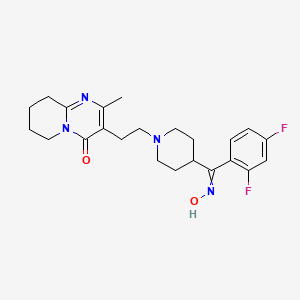
Risperidone E-Oxime
概要
説明
Risperidone E-Oxime is a complex organic compound with potential applications in various fields such as chemistry, biology, medicine, and industry. This compound is characterized by its unique structure, which includes a difluorophenyl group, a piperidine ring, and a tetrahydropyridopyrimidinone core.
準備方法
Synthetic Routes and Reaction Conditions
The synthesis of Risperidone E-Oxime typically involves multiple steps, including the formation of the piperidine ring, the introduction of the difluorophenyl group, and the construction of the tetrahydropyridopyrimidinone core. Specific reaction conditions, such as temperature, pressure, and the use of catalysts, are crucial for the successful synthesis of this compound.
Industrial Production Methods
Industrial production methods for this compound may involve large-scale synthesis techniques, including continuous flow reactors and automated synthesis systems. These methods aim to optimize yield, purity, and cost-effectiveness while ensuring safety and environmental compliance.
化学反応の分析
Types of Reactions
Risperidone E-Oxime can undergo various chemical reactions, including:
Oxidation: The compound can be oxidized to form different oxidation states.
Reduction: Reduction reactions can modify the functional groups within the compound.
Substitution: Substitution reactions can introduce new functional groups or replace existing ones.
Common Reagents and Conditions
Common reagents used in these reactions include oxidizing agents (e.g., potassium permanganate), reducing agents (e.g., sodium borohydride), and various nucleophiles and electrophiles for substitution reactions. Reaction conditions such as solvent choice, temperature, and pH play a significant role in determining the outcome of these reactions.
Major Products Formed
The major products formed from these reactions depend on the specific reagents and conditions used. For example, oxidation may yield different oxidized derivatives, while substitution reactions can produce a variety of substituted analogs.
科学的研究の応用
Chemistry
In chemistry, this compound can be used as a building block for the synthesis of more complex molecules. Its unique structure allows for the exploration of new chemical reactions and pathways.
Biology
In biological research, this compound may be used to study its interactions with various biological targets, such as enzymes and receptors. Its potential as a biochemical probe can provide insights into cellular processes and mechanisms.
Medicine
In medicine, Risperidone E-Oxime may have therapeutic potential due to its ability to interact with specific molecular targets. Research into its pharmacological properties could lead to the development of new drugs.
Industry
In industry, this compound can be used in the development of new materials, such as polymers and coatings. Its unique chemical properties may enhance the performance and durability of these materials.
作用機序
The mechanism of action of Risperidone E-Oxime involves its interaction with specific molecular targets, such as enzymes or receptors. These interactions can modulate various biochemical pathways, leading to the compound’s observed effects. The exact molecular targets and pathways involved depend on the specific application and context of use.
類似化合物との比較
Similar Compounds
- 2-{2-[(4-Methoxyphenoxy)methyl]phenyl}-4,4,5,5-tetramethyl-1,3,2-dioxaborolane
- N-(4-Ethoxybenzyl)-2-(4,4,5,5-tetramethyl-1,3,2-dioxaborolan-2-yl)benzenamine
- Spiropyrans
Uniqueness
Compared to these similar compounds, Risperidone E-Oxime stands out due to its unique combination of functional groups and structural features
特性
分子式 |
C23H28F2N4O2 |
|---|---|
分子量 |
430.5 g/mol |
IUPAC名 |
3-[2-[4-[C-(2,4-difluorophenyl)-N-hydroxycarbonimidoyl]piperidin-1-yl]ethyl]-2-methyl-6,7,8,9-tetrahydropyrido[1,2-a]pyrimidin-4-one |
InChI |
InChI=1S/C23H28F2N4O2/c1-15-18(23(30)29-10-3-2-4-21(29)26-15)9-13-28-11-7-16(8-12-28)22(27-31)19-6-5-17(24)14-20(19)25/h5-6,14,16,31H,2-4,7-13H2,1H3 |
InChIキー |
BRCINVRBDDVLDW-UHFFFAOYSA-N |
正規SMILES |
CC1=C(C(=O)N2CCCCC2=N1)CCN3CCC(CC3)C(=NO)C4=C(C=C(C=C4)F)F |
製品の起源 |
United States |
Synthesis routes and methods I
Procedure details









Synthesis routes and methods II
Procedure details







Synthesis routes and methods III
Procedure details







試験管内研究製品の免責事項と情報
BenchChemで提示されるすべての記事および製品情報は、情報提供を目的としています。BenchChemで購入可能な製品は、生体外研究のために特別に設計されています。生体外研究は、ラテン語の "in glass" に由来し、生物体の外で行われる実験を指します。これらの製品は医薬品または薬として分類されておらず、FDAから任何の医療状態、病気、または疾患の予防、治療、または治癒のために承認されていません。これらの製品を人間または動物に体内に導入する形態は、法律により厳格に禁止されています。これらのガイドラインに従うことは、研究と実験において法的および倫理的な基準の遵守を確実にするために重要です。
![N-[2-(Chloroacetyl)-5-isopropylphenyl]acetamide](/img/structure/B8742109.png)

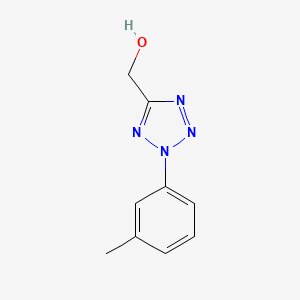
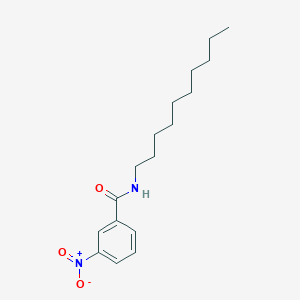

![8-Bromo-4,5-dihydrobenzo[b]thieno[2,3-d]oxepine-2-carboxylic acid](/img/structure/B8742163.png)
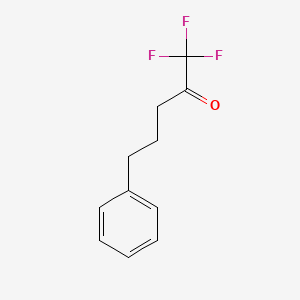

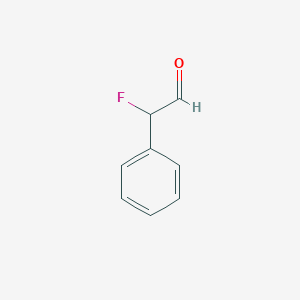


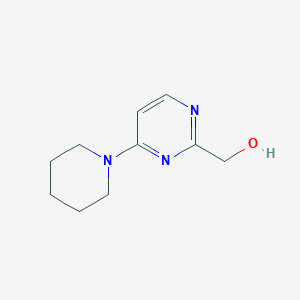
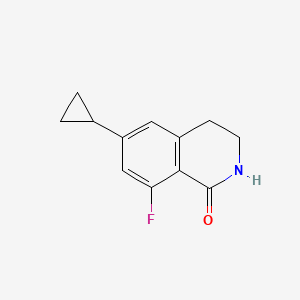
![1-Chloro-4-[(chloromethoxy)methyl]benzene](/img/structure/B8742236.png)
